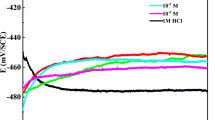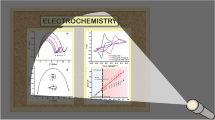Abstract
Nickel surface state has been studied by means of electrochemical impedance spectroscopy (EIS) method. The experiments were performed in sodium hydroxide solutions in the concentrations range from 0.001 to 0.1 M at the different levels of the potentiostatic anodic polarization. Two semicircles have been observed on the Nyquist diagram at the potentials below + 400 mV (Ag/AgCl). The high-frequency arc is caused by ionic charge transfer from the electrolyte through the barrier oxide-hydroxide layer on the electrode surface. Another low-frequency semicircle on the Nyquist diagram is related to the Faraday oxidation processes at the solid-phase boundary between the oxide and the metal. An equivalent circuit that is adequate to the experimental EIS results was chosen. The correlation of the equivalent circuit element parameters with the variable experimental factors, such as the sodium hydroxide concentration and the anodic polarization level, has been analyzed. It has been established that the ionic charge transfer resistance across the liquid phase and oxide-hydroxide boundary practically does not depend on the potential, but obeys a power dependence on the alkali concentration and can be described in terms of the Freundlich isotherm. The electrical double layer capacity of nickel electrode is a square root function of the alkali concentration, i.e., corresponds to the classical Gouy-Chapman model. The model element parameters corresponding to the Faraday process on the metal, on the contrary, are weakly dependent on the alkali concentration, and are determined by the applied anodic potential.
Graphical abstract
Dependence of (a) the charge transfer resistance R1, and (b) the electrical double layer capacity of Ni electrode on the alkali concentration (averaged results for the entire potential range).












Similar content being viewed by others
Notes
The Dummy Circuits Solver computer program, based on the use of the gully function algorithm to optimize the parameters of the equivalent circuit elements at the analysis of experimental EIS results.
The ZMonitor software allows to display the EIS data in the different kinds of diagrams. Both programs were developed by V.E. Kasatkin specifically for use with the IPC–FRA electrochemical complex.
There is no noticeable influence of additional electrode processes associated, for example, with anodic oxygen evolution.
In the original publication [14], these potentials are given relative to SHE. We recalculated those potentials to the saturated silver chloride electrode scale in order to coordinate with those used in this work.
References
V.E. Kasatkin, L.P. Kornienko, A.I. Shcherbakov, I.G. Korosteleva, I.V. Kasatkina, V.N. Dorofeeva, Study of the surface state of nickel electrode during polarization in an alkaline medium by electrochemical impedance spectroscopy method. Int J Corros Scale Inhib 9, 1516–1529 (2020)
S. Krakowiak, K. Darowicki, P. Ślepski, Impedance of metastable pitting corrosion. J Electroanal Chem 575, 33–38 (2005)
S.V. Gnedenkov, S.L. Sinebryukhov, The structure and morphological features of the layers formed on the surface of titanium. Corrosion: maters protection 2, 2–8 (2004)
N. Mahato, M.M. Singh, Investigation of passive film properties and pitting resistance of ALSI 316 in aqueous ethanoic acid containing chloride ions using electrochemical impedance spectroscopy (EIS). Port Electrochim Acta 29, 233–251 (2011)
A.I. Shcherbakov, I.G. Korosteleva, I.V. Kasatkina, V.E. Kasatkin, L.P. Kornienko, V.N. Dorofeeva, V.V. Vysotskii, V.A. Kotenev, Impedance of aluminum electrode with nanoporous oxide. Prot Met Phys Chem Surf 55, 689–694 (2019)
M.A. Maleeva, A.A. Rybkina, A.I. Marshakov, V.V. Elkin, The effect of atomic hydrogen on the anodic dissolution of iron in a sulfate electrolyte studied with impedance spectroscopy. Prot. Met 44, 548–556 (2008)
E. Barsoukov, J.R. Macdonald, Impedance spectroscopy: theory, experiment, and applications (Wiley, New York, 2018)
Yu.V. Emelyanova, M.V. Morozova, Z.A. Mikhailovskaya, E.S. Buyanova, Impedance spectroscopy: theory and application (Ural Publishing House University, Yekaterinburg, Ministry of Education and Science RF, 2017)
M.E. Orazem, B. Tribollet, Electrochemical impedance spectroscopy (Wiley, New York, 2008)
D. Dobos, Electrochemical data (A hand book for electrochemists in industry and universities, Mir, Moscow, 1980)
A.W. Adamson, A.P. Gast, Physical chemistry of surfaces (Wiley, New York, 1997)
D.S. Hall, D.J. Lockwood, C. Bockand, B.R. MacDougall, Nickel hydroxides and related materials: a review of their structures, synthesis and properties. Procs: Mathematical, Phys Eng Sci 471(2), 1–65 (2015). https://doi.org/10.1098/rspa.2014.0792
E.B. Ferreira, S. Tahmasebi1, G. Jerkiewicz, On the electrochemical reduction of β‑Ni(OH)2 to metallic nickel. Electrocatalysis 12, 199–209 (2021). https://doi.org/10.1007/s12678-021-00643-0
E.B. Ferreira, S. Tahmasebi, G. Jerkiewicz, On the catalytic activity and corrosion behavior of polycrystalline nickel in alkaline media in the presence of neutral and reactive gases. Electrocatalysis 12, 146–164 (2021). https://doi.org/10.1007/s12678-020-00637-4
Author information
Authors and Affiliations
Corresponding author
Ethics declarations
Competing Interests
The authors declare no competing interests.
Additional information
Publisher's Note
Springer Nature remains neutral with regard to jurisdictional claims in published maps and institutional affiliations.
Rights and permissions
About this article
Cite this article
Kasatkin, V.E., Kornienko, L.P., Shcherbakov, A.I. et al. Effect of Sodium Hydroxide Concentration on Nickel Surface State: Experience in EIS Methods Applying. Electrocatalysis 13, 539–550 (2022). https://doi.org/10.1007/s12678-022-00735-5
Accepted:
Published:
Issue Date:
DOI: https://doi.org/10.1007/s12678-022-00735-5




